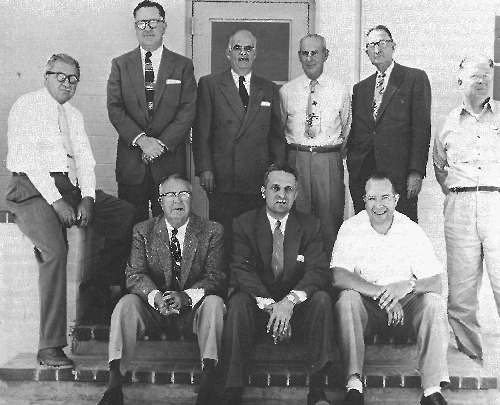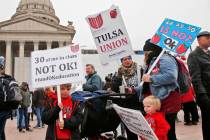Valley namesake expanded, monitored water supply
The stories in the Las Vegas Review-Journal spoke of downtown revitalization, legal issues involving North Las Vegas, Lake Mead at a record low level and massive home building in the valley. It wasn't a paper from a few years ago; it was from 1954, and Thomas A. Campbell was right in the middle of the water issues.
Water is the reason most cities are where they are, and Las Vegas is no exception. The area was originally settled on the banks of Las Vegas Creek, flowing from springs and ponds at the site of what is now the Springs Preserve at 333 S. Valley View Blvd. The rare verdant green patch in the desert gave the town its name, Las Vegas, Spanish for "The Meadows." That water made the area a good stopping point for the railroad.
By the mid-1940s, the flow from the springs was having a hard time keeping up with the valley's abundant growth. In October 1948 the Las Vegas Valley Water District was formed by a special election to ensure that the rapidly growing city didn't simply dry up and blow away.
Campbell was one of the founding members of the water district. Within a month of the group's formation, he was elected vice president under the water district's first president, Harry Miller.
Dennis McBride, curator of history and collections at Nevada State Museum's Las Vegas branch, said there is a wealth of information on Campbell.
"Campbell was born in 1896 and attended college at the University of California, Berkeley," McBride said. "He served in the Navy in World War I."
For a time Campbell was a newspaper editor in San Francisco and later a stock broker in Los Angeles. By 1937 he was in Reno working in real estate, and he moved to Las Vegas the following year.
He dealt with several significant properties, selling the land where the original Sears department store was built on Fremont Street and the property that became the Desert Inn golf course.
"He had the idea for a horse track in Paradise Valley," McBride said. "Later that became the Thunderbird Downs."
Campbell also seemed to have a penchant for becoming vice president of local organizations. He held that position for the Las Vegas Chamber of Commerce in 1946 and the Nevada State Real Estate Board in 1947. He broke that streak in 1950 when he succeeded Miller to the presidency of the water district.
By that point, he already had been integral to the acquisition of property surrounding the Las Vegas Springs. Although some of that land was later resold, becoming retail shopping and much of the parking lot of the Meadows Mall, the majority of the property is still owned by the water district today, including the Springs Preserve and the water district offices on the corner of Charleston and Valley View b oulevards.
Although the railroad ceased to be the dominant business in town following the closure of the yards in 1927, water production, storage and distribution facilities were still owned and operated by the Los Angeles & Salt Lake Railroad Company, Union Pacific Railroad Company and the Las Vegas Land and Water Company in 1954.
The papers of the time made frequent references to the "water shortage" and the "water crisis." The situation was so bad that the stories often listed the gallons of water used on a particular day, and water pressure at times became so low that water could not reach the second floor of some buildings. A police crackdown dealt with water wasters.
Campbell was in Los Angeles in late June 1954 negotiating the details of the transfer of water operations to the water district. Although the July 1 edition of the Las Vegas Review-Journal had an article touting the transfer of power, Campbell wasn't mentioned as L.R. Maag, who had been manager of the Las Vegas Land and Water Company, ceremoniously handed the key over to William Renshaw, who had been hired to manage the water district.
The next year it was Campbell who had to make the request to the state to authorize charging for water and installing meters.
The city had the rights to a certain amount of water from Lake Mead, but until then it had not exercised them. Under Campbell, pipes and pumps were put in place to facilitate the use of water from the lake.
In a five-page letter to Campbell, Nevada Attorney General Harvey Dickerson opined that the water district had the legal right to install meters and charge for the water it was providing. Among the reasons he mentioned was a report from the state engineer that meters were desirable as a conservation method and Dickerson's opinion that the Legislature's creation of the water district " gave to it the broadest conceivable powers. The reason for this must be apparent to the most casual observer."
Campbell's time with the water district was a short but important decade.
"Mr. Campbell continued to serve on the LVVWD Board of Directors until the spring of 1958," wrote Tom Bradley, public information officer for the Las Vegas Valley Water District and the Southern Nevada Water Authority. "My understanding is he resigned due to health reasons, but I've been unable to confirm the nature of those issues."
In 1968 the water district began construction of what was then called the Flamingo Pump Station and Reservoir at 4100 E. Flamingo Road.
On Aug. 14, 1969, Campbell attended the dedication ceremony for the station that by then had been named the Thomas A. Campbell Pump Station and Reservoir.
Campbell Drive near the original water district offices also honors the water management pioneer.
Contact Sunrise/Whitney View reporter F. Andrew Taylor at ataylor@viewnews.com or 380-4532.
Naming Las Vegas
The history behind the naming of various streets, parks, schools, public facilities and other landmarks in the Las Vegas Valley will continue to be explored in a series of feature stories appearing in View editions published on the first Tuesday of every month.
If you're curious about how or why something got its name, post a comment on our Facebook page, facebook.com/viewnewspapers, or email sblust@viewnews.com.
Thanks for reading View.














